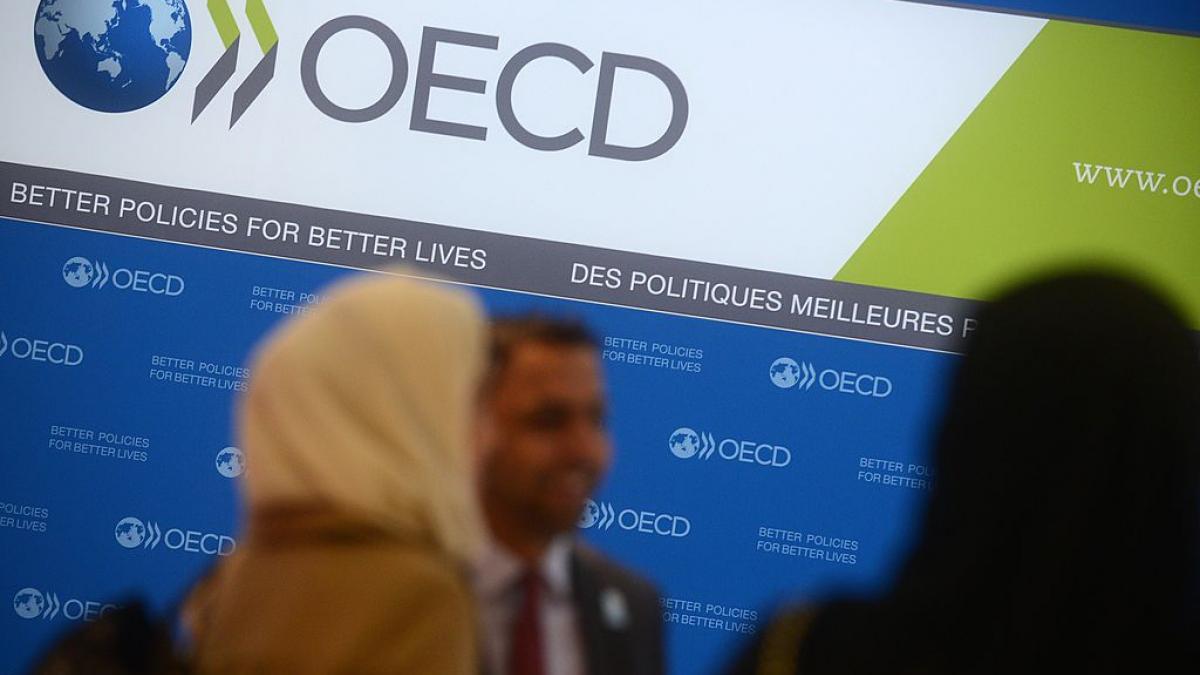Collective bargaining is associated with lower income inequality
There is a negative correlation between collective bargaining coverage and inequality, but more research is needed to understand why.

In most developed economies, wages and working conditions are set through a collective bargaining process involving various social partners, typically trade unions, employers’ organisations and the government. These arrangements are complex and vary considerably from country to country. Some economists have suggested that declining unionisation increases income inequality (Freeman and Medoff, 1984; Card et al, 2007; Stansbury and Summers, 2020). In this analysis, we explore trends in union density and collective-bargaining coverage to better understand their relationship with income inequality in Organisation for Economic Co-operation and Development countries.
De-unionisation does not always result in lower collective-bargaining coverage
In collective bargaining process with employers, the primary goal of trade unions is improving and maintaining terms and conditions of work. Employers’ associations also often participate in collective bargaining. They can be organised either at sectoral level, like the German metal and electrical industry association Gesamtmetall, or at national level, like the Italian Confindustria. In the United States, in contrast to EU countries, the bargaining happens mainly at firm level, and thus employers’ associations do not directly take part.
Trade union membership has declined over the past decades in the EU and the US, but to varying degrees (Figure 1).
US unionisation halved from the already low rate of around 22 percent in 1980 to 10 percent by 2020. Eastern EU countries experienced the sharpest decline in unionisation in the 1990s as part of their transitions from the socialist economic system, in which union membership was a method of signalling political preferences and was seen as a prerequisite for career progression. As these countries became market economies, unionisation declined sharply, to close to 10 percent, nearing US values. The UK and Ireland went from having more than half of their labour forces represented by a union in the early 1980s, to only a quarter by 2020. Although there has been decline everywhere, the decrease in unionisation has been less pronounced in Scandinavian, Southern, and Western EU.
The outcome of collective bargaining is often extended beyond the union and employer association members (Eurofund, 2015). One of the reasons is the existence of erga omnes (towards everyone) clauses: if an agreement is signed between an employer and a trade union, under erga omnes clauses, all workers are covered by the agreement. Moreover, in Europe, there is a tradition of extending negotiated agreements to non-unionised workers within a sector, and even to companies that were not originally involved in the bargaining process. Because of these extension mechanisms, a collective bargaining coverage rate higher than unionisation density can be observed in nearly all studied countries (Figure 2).
For example, in Germany, a bargaining agreement signed between an employer association and a union covers all the firms that are part of the employer association. Moreover, covered firms usually apply erga omnes clauses and extend the coverage to all employees, regardless of union membership (Jäger et al, 2022). In 2018, this resulted in a trade union density of 17 percent compared to a collective bargaining coverage rate of 54 percent. The sharp decline in coverage for Southern Europe at the end of the sample period is a consequence in particular of the reforms to reduce the extension mechanisms that Greece undertook after 2010 in the context of its financial assistance programme. Greece’s 100 percent coverage rate in 2011 declined to 14 percent by 2017 (see the Annex for country-specific charts).
The literature on the link between trade union density and income inequality is scant
Research on the economic consequences of either trade union density or collective bargaining processes on macroeconomic variables is relatively scarce (Bhuller et al, 2022). Only a few recent papers have studied the causal effect of trade union density on income inequality. Jaumotte and Osorio Buitron(2020) analysed cross-country data and found a negative correlation between union density and the income share of the top 10 percent earners and the Gini coefficient. Farber et al (2021) presented time-series evidence from the US and demonstrated a negative correlation between union density and income inequality. Farber et al (2021) argued that this negative correlation resulted partially from the causal effects of increased unionisation on decreased inequality. For Germany, Dustmann et al (2009) concluded that if the unionisation rate had not declined in the 1990s, wages would have been higher, especially for workers at the bottom of the income distribution.
New cross-section and time-series evidence on collective bargaining and inequality
In a paper we prepared for the Transatlantic Expert Group on the Future of Work (Darvas et al, 2023), we presented new cross-section and time-series evidence on the correlation between income inequality and unionisation and collective bargaining.
Figure 3 confirms a negative correlation, -0.38, between trade union density and the Gini coefficient of income inequality for 37 countries, which is statistically significant. The correlation between trade union density and other indicators, such as the income share of the top 10 percent and top 20 percent of earners, and the income quintile share ratio (the ratio of total income received by the 20 percent of the population with the highest income to that received by the 20 percent of the population with the lowest income) is similarly negative. The correlation between trade union density and the income share of the bottom 10 percent or 20 percent of earners is positive.
Figure 3 suggests that five Nordic countries and Belgium form a separate group by having relatively high levels of union density and low income inequality. When we exclude these six countries, the correlation coefficient falls to -0.08, which is not statistically different from zero, suggesting that these six countries drive the negative correlation.
Among all countries for which data is available, we find an even higher correlation (in absolute terms) between the share of workers covered by collective bargaining, which is -0.52 (Figure 4). This estimate is highly statistically significant. When excluding the six Nordic countries and Belgium, the correlation coefficient remains high at -0.40, which continues to be statistically significant. These findings suggest that collective bargaining coverage could be a more important factor in influencing inequality than union density. This is an intuitive result, since the conclusions of collective bargaining are extended beyond trade union and employer association members, as discussed above. If such bargaining can increase the relative wages of poorer workers and thereby reduce income inequality, then collective bargaining coverage is a more meaningful indicator than unionisation for capturing this effect.
Nevertheless, these cross-country correlation coefficients should be assessed cautiously and might not be interpreted as a causal relationship. Assessing the causal impact of trade union density and collective bargaining on income inequality is fraught with serious difficulties. Income inequality is influenced by various factors, including market forces that determine pre-redistribution (before taxes and transfers) incomes, and redistributive policies that shift income from the rich to the poor. In principle, trade unions could influence both the market distribution (for example, by increasing the gross relative wages of low-earners) and redistribution policies (for example, by lobbying the government). However, identifying the contribution of trade unions is inherently difficult, and we cannot exclude other factors from influencing both indicators. For example, in a country with a high level of social sensitivity and solidarity, voters might elect governments that pursue redistributive policies and workers might be more willing to join trade unions, resulting in a negative correlation between union density and income inequality.
Such country-wide preferences might be less of an issue for within-country temporal change in the indicators, provided these preferences are persistent. There are 12 countries in the OECD/AIAS ICTWSS dataset for which data on trade union density, collective bargaining and income inequality (which we take from the Standardised World Income Inequality dataset of Solt, 2019) is available for at least 50 years for all indicators. These 12 countries include six European Union countries, the United States, and five other countries.
We use data sampled in every fifth year for two reasons. First, trade union membership and collective bargaining might influence inequality with a time lag. Second, for several countries, data on collective bargaining coverage is available only for every fifth year in the period before 2000.
Since trade union density, collective bargaining coverage and inequality have trends in most countries, we work with differenced data. That is, we calculate the five-year changes in the indicators.
For ten of the 12 countries, both correlation coefficients are negative, and a large share of them are statistically different from zero (Table 1). These findings again highlight a negative association between bargaining and inequality. For France, the correlation coefficient is positive when trade union density is used, while for Ireland, both correlation coefficients are positive. Further research should explore the reasons behind the differing French and Irish results.
Table 1: Trade unions/collective bargaining and income inequality: correlation coefficients between five-year changes
We have identified a negative correlation between union density and collective wage bargaining and inequality across countries and over time. These correlations are noteworthy, even if we are uncertain whether they reflect a causal relationship. However, it is important to recognise that the collective-bargaining systems in these countries vary significantly, and therefore the details of how they affect inequality are still unknown. Further research should investigate how these different systems impact the strength and direction of the correlation between union density and inequality in each country. Additionally, it is crucial to explore the impact of collective bargaining on employment and output, as these factors also play significant roles in shaping the overall economic landscape.
References
Bhuller, M., K.O. Moene, M. Mogstad and O.L. Vestad (2022) ‘Facts and Fantasies about Wage Setting and Collective Bargaining’, Journal of Economic Perspectives 36(4): 29–52, available at https://doi.org/10.1257/jep.36.4.29
Card, D., T. Lemieux and W.C. Riddell (2007) ‘Unions and Wage Inequality’, in J.T. Bennett and B.E. Kaufman (eds) What Do Unions Do? Routledge
Darvas, Z, G. Gotti and K. Sekut (2023) ‘Trade unions, collective bargaining, and income inequality: a transatlantic comparative analysis’, paper prepared for the Transatlantic Expert Group on the Future of Work
Dustmann, C., J. Ludsteck and U. Schönberg (2009) ‘Revisiting the German Wage Structure’, The Quarterly Journal of Economics, 124(2): 843–81
Eurofound (2015) Collective Bargaining in Europe in the 21st Century, European Foundation for the Improvement of Living and Working Conditions
Farber, H.S., D. Herbst, I. Kuziemko and S. Naidu (2021) ‘Unions and Inequality over the Twentieth Century: New Evidence from Survey Data*’, The Quarterly Journal of Economics, 136(3): 1325–85, available at https://doi.org/10.1093/qje/qjab012
Freeman, R.B. and J.L. Medoff (1984) What Do Unions Do? N.Y. Basic Books
Jäger, S., S. Noy, and B. Schoefer (2022) ‘The German Model of Industrial Relations: Balancing Flexibility and Collective Action’, Collective ActionJaumotte, F., and C. Osorio Buitron (2020) ‘Inequality: traditional drivers and the role of union power’, Oxford Economic Papers, 72:1, 25–58, https://doi.org/10.1093/oep/gpz024
Jaumotte, F., and C. Osorio Buitron (2020) ‘Inequality: traditional drivers and the role of union power’, Oxford Economic Papers, 72:1, 25–58, available at https://doi.org/10.1093/oep/gpz024
Solt, F. (2020) ‘Measuring Income Inequality Across Countries and Over Time: The Standardized World Income Inequality Database’, Social Science Quarterly 101(3):1183-1199, SWIID Version 9.4, November 2022, https://doi.org/10.1111/ssqu.12795
Stansbury, A. and L.H. Summers (2020) ‘The Declining Worker Power Hypothesis: An Explanation for the Recent Evolution of the American Economy’, Brookings Papers on Economic Activity, 2020(1): 1–96, available at https://doi.org/10.1353/eca.2020.0000
Annex



